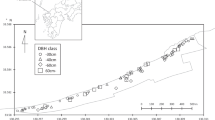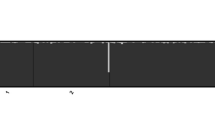Abstract
The genetic diversity and mating status of seed production stands are crucial factors impacting the genetic quality and ecological stability of progeny plantations. The genetic homogeneity of seeds collected from a seed production population in different years has not yet been clearly described. In this study, the genetic diversity and differentiation of a seed-tree stand of 58-year-old Pinus massoniana (P1959) and four-open pollinated plantations of its progeny (OS1996, OS2000, OS2006 and OS2015) were determined by using microsatellite markers. The results showed that similar high genetic diversity was preserved in the seed-tree stand and its four progenies. This implied that current artificial seed harvesting from the seed-tree stand for reforestation does not lead to a significant reduction in genetic diversity; the F index across most loci was significantly greater than zero, indicating population homozygote excess. The pairwise genetic differentiation of the five populations ranged from 0.035 to 0.075, among which OS2015 was the most differentiated from the parent. The differentiation between the parental population and its progeny seemed to increase with increasing age of the seed-trees. This implied that a limited pollination coupled with variable within-stand pollen availability has created opportunities for both self- and foreign pollination to be successful in various periods, resulting in a seemingly paradoxical scenario of both high selfing and gene flow, ultimately resulting in gradually increasing differences in the gene frequency composition between the parental population and its progeny. Management considerations in addressing these problems in similar seed production stands were discussed.




Similar content being viewed by others
Change history
04 March 2021
A Correction to this paper has been published: https://doi.org/10.1007/s10342-021-01367-y
References
Adams W, Hipkins VD, Burczyk J, Randall W (1997) Pollen contamination trends in a maturing Douglas-fir seed orchard. Can J For Res 27:131–134
Ai C, Xu LA, Lai HL, Huang MR, Wang ZR (2006) Genetic diversity and paternity analysis of a seed orchard in Pinus massoniana. Scientia Silvae Sinicae 42:146–150
Bai TD (2013) Construction of second generation breeding population from open-pollinated progeny tests of Pinus massoniana seed orchard. Nanjing Forestry University, Nanjing
Bai TD, Xu LA, Xu M, Wang ZR (2014) Characterization of masson pine (Pinus massoniana Lamb.) microsatellite DNA by 454 genome shotgun sequencing. Tree Genet Genom 10:429–437
Chaix G, Vigneron P, Razafimaharo V, Hamon S (2010) Improved management of malagasy Eucalyptus grandis seed orchards using microsatellites and paternity assignment. J Trop For Sci 22:271–280
Duan HJ et al (2015) Genetic characterization of red-colored heartwood genotypes of Chinese fir using simple sequence repeat (SSR) markers. Genet Mol Res Gmr 14:18552
Feng YH, Li HG, Yang ZQ, Wu DS (2016) Genetic structure of Pinnus massoniana on Tongmian natural populations in Guangxi. Guihaia 2016:11
Feng YH, Yang ZQ, Jia J, Li HG, Huang YL (2017) Temporal variation of mating system in a seed orchard of Pinus massoniana. J Northeast For Univ 45:1–5
Ferreira DK, Nazareno AG, Mantovani A, Bittencourt R, Sebbenn AM, Dos Reis MS (2012) Genetic analysis of 50-year old Brazilian pine (Araucaria angustifolia) plantations: implications for conservation planning. Conserv Genet 13:435–442
Frichot E, Francois O (2015) LEA: An R package for landscape and ecological association studies. Methods Ecol Evol 6:925–929
Frichot E, Mathieu F, Trouillon T, Bouchard G, Francois O (2014) Fast and efficient estimation of individual ancestry coefficients. Genetics 196:973–983
Funda T, Wennström U, Almqvist C, Gull BA, Wang XR (2016) Mating dynamics of Scots pine in isolation tents. Tree Genet Genom 12:112
Ganatsas P, Tsakaldimi M, Thanos C (2008) Seed and cone diversity and seed germination of Pinus pinea in Strofylia Site of the Natura 2000. Netw Biodivers Conserv 17:2427–2439. https://doi.org/10.1007/s10531-008-9390-8
Gonzaga JMS, Manoel RO, Sousa ACB, Souza AP, Moraes MLT, Freitas MLM, Sebbenn AM (2016) Pollen contamination and nonrandom mating in a Eucalyptus camaldulensis Dehnh seedling seed orchard. Silvae Genet 65:1–11
Goudet J (2005) HIERFSTAT, a package for R to compute and test hierarchical F-statistics. Mol Ecol Notes 5:184–186
Grattapaglia D, Ribeiro VJ, Rezende GDSP (2004) Retrospective selection of elite parent trees using paternity testing with microsatellite markers: an alternative short term breeding tactic for Eucalyptus. Theor Appl Genet 109:192–199
Heras J, Domínguez C, Mata E, Pascual V, Lozano C, Torres C, Zarazaga M (2015) GelJ–a tool for analyzing DNA fingerprint gel images. BMC Bioinform 16:270
Holsinger KE, Weir BS (2009) Genetics in geographically structured populations: defining, estimating and interpreting F(ST). Nat Rev Genet 10:639–650
Jacquelyn B, Marilyn C, Selvadurai D (2005) Microsatellite analysis reveals genetically distinct populations of red pine (Pinus resinosa, Pinaceae). Am J Bot 92:833–841
Jombart T, Ahmed I (2011) adegenet 1.3-1: new tools for the analysis of genome-wide SNP data. Bioinformatics 27:3070–3071
Jombart T, Devillard S, Balloux F (2010) Discriminant analysis of principal components: a new method for the analysis of genetically structured populations. BMC Genet 11:94–94
Kassambara A (2018) ggpubr: 'ggplot2' Based Publication Ready Plots. R package version 0.1.8. https://CRAN.R-project.org/package=ggpubr
Kess T, El-Kassaby YA (2015) Estimates of pollen contamination and selfing in a coastal Douglas-fir seed orchard. Scand J For Res 30:266–275
Liu Q, Wei Y, Xu L, Hao Y, Chen X, Zhou Z (2017) Transcriptomic profiling reveals differentially expressed genes associated with pine wood nematode resistance in Masson pine (Pinus massoniana Lamb). Scientific Reports 7:4693
Ni ZX, Bai TD, Cai H, Chen SF, Xu LA (2015) The transferability of Pinus massoniana SSR in other Pinus species. Mol Plant Breed 13:2811–2817
Nie YX, Wei X, Zhang R, Zhang HD, Zhou ZF, Bai TD (2016) Seed quality and genetic diversity of Pinus massoniana seed production stand in Guangxi. Shaanxi Forest Science and Technology, Shaanxi, pp 21–26
Nikkanen T, Velling P (1987) Correlations between flowering and some vegetative characteristics of grafts of Pinus sylvestris. For Ecol Manag 19:35–40
Peakall R, Smouse PE (2006) GENALEX 6: genetic analysis in Excel. Population genetic software for teaching and research. Mol Ecol Notes 6:288–295
Peakall R, Smouse PE (2012) GenAlEx 6.5: genetic analysis in Excel. Population genetic software for teaching and research—an update. Bioinformatics 28:2537–2539
Potter KM, Hipkins VD, Mahalovich MF, Means RE (2015) Nuclear genetic variation across the range of ponderosa pine (Pinus ponderosa): phylogeographic, taxonomic and conservation implications. Tree Genet Genomes 11:38. https://doi.org/10.1007/s11295-015-0865-y
R Core Team (2018) R: a language and environment for statistical computing. R Foundation for Statistical Computing, Vienna, Austria. https://www.R-project.org/
Slavov GT, Howe GT, Adams WT (2005) Pollen contamination and mating patterns in a Douglas-fir seed orchard as measured by simple sequence repeat markers. Can J For Res 35:1592–1603
Tan X (2011) study on the selection of second-generation breeding parents and the mating system of seed orchid in Pinus massoniana. Chinese Academy of Forestry, Beijing
Tíscar Oliver PA (2002) Reproductive capacity of Pinus nigra ssp. salzmannii in relation to mother plant age Investigación Agraria Sistemas Y Recursos Forestales
Wojnicka-Półtorak A, Celiński K, Chudzińska E (2017) Genetic diversity among age classes of a Pinus sylvestris (L.) population from the Białowieża Primeval forest. Poland For 8:227
Xie SG, Shao JX, Huang RZ, Liao ZW, Li RX, Huo C (1997) Excellent stand and its progeny performance of masson pine (Pinus massoniana) in Tianhongling, Guangxi. In: Chinese forest tree genetics and breeding for the 21st century-collection of the 4th annual conference of forest tree genetics and breeding of Chinese society of forestry, Guilin, China
Zeng WS, Zhang HR, Tang SZ (2011) Using the dummy variable model approach to construct compatible single-tree biomass equations at different scales—a case study for Masson pine (Pinus Massoniana) in Southern China. Revue Canadienne De Recherche Forestière 41:1547–1554
Zhang W, Gong J, Ji KS (2008) Genetic diversity for seedling orchard of Masson’s pine. Mol Plant Breed 6:717–723
Zhou Z (2000) Masson pine in China, 1st edn. China Forestry Publishing House, Beijing
Zhou ZC, Qin GF, Li GR, Huang GL, Lan YZ, Zhong DH (1997) Achievements, problems and its countermeasures of genetic improvement of Masson pine. For Res 10:435–442
Author information
Authors and Affiliations
Contributions
T-DB received and supervised the research project. T-DB, W-XJ and Z-QY designed the experiment and analysed the data. M-XC performed the experiments. J-PY collected the plant materials. W-XJ and T-DB wrote and edited the manuscript.
Funding
This work was supported by National Natural Science Foundation of China (No. 31400575) and Natural Science Foundation of Guangxi (No. 2018GXNSFBA281110).
Corresponding author
Ethics declarations
Conflict of interest
The authors declare that they have no conflict of interest.
Ethics approval
This article does not contain any studies involving animals or human participants performed by any of the authors.
Additional information
Communicated by Oliver Gailing.
Publisher's Note
Springer Nature remains neutral with regard to jurisdictional claims in published maps and institutional affiliations.
The original online version of this article was revised: In the original publication of the article, the Funding information was missed and it has been given in the correction.
Supplementary Information
Below is the link to the supplementary information.
Rights and permissions
About this article
Cite this article
Bai, TD., Chen, MX., Ye, JP. et al. Similar genetic diversity but increased differentiation revealed among a 58-year-old Pinus massoniana seed-tree stand and its progenies generated at different ages. Eur J Forest Res 140, 649–656 (2021). https://doi.org/10.1007/s10342-021-01353-4
Received:
Revised:
Accepted:
Published:
Issue Date:
DOI: https://doi.org/10.1007/s10342-021-01353-4




